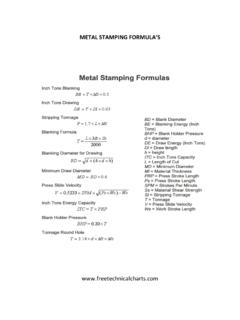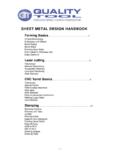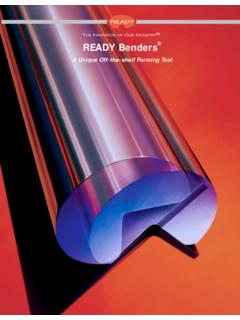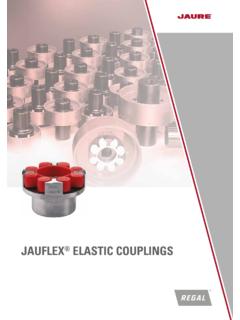Transcription of Designing With Metal Bellows - Sigma-Netics
1 WHITE PAPER 2015 Sigma-Netics , Inc. | 2 North Corporate Drive, Riverdale, NJ 07457 | Tel: 973-616-6900 | with Metal BellowsMetal Bellows have long been a key component in demanding sensing and sealing applications. In fact, they ve become so familiar that many engineers now think of Bellows as generic items: Just specify a few key dimensions, pick a Metal alloy and you re good to go. The reality, however, is that not all Bellows technologies are created equal. Different manufacturing methods and material grades can have profound effects on how Metal Bellows will perform in terms of their stroke, pressure capabilities, spring rate and temperature response. Manufacturing methods and materials will also determine how long your Bellows will last in the field. The wrong Bellows may work for a short time but not achieve your expected lifecycle.
2 To be successful with Metal Bellows , start with an understanding of the basic design and sizing inputs. Bellows have some specification requirements that you probably didn t cover in engineering school. Next, pay close attention to the distinction between different welded and seamless constructions. Each type strikes a different balance between cost and performance, and each has its own application sweet , consider the type of materials. Sometimes the choice of Bellows materials will be obvious. But more often you ll be confronted with choices between different Metal alloys, any one of which could meet your s a closer look at what you need to know to pick the right type of Bellows for your application: DESIGN CONSIDERATIONST hink of Bellows as a combination of a piston and a spring.
3 Like a piston, Bellows can convert changes in their internal or external pressure into an applied force. Like a spring, Bellows deflect elastically in response to an applied force and exert a reactive force. And like a spring, Bellows exhibit hysteresis and linearity effects that you ll need to account for in your designs (see Force vs Deflection chart).Having the characteristics of both a piston and spring makes Bellows a very versatile component. Bellows are used in dozens of different sensing, fluid handling and actuation applications. In general, these applications fall into four broad categories sealing, temperature, evacuation and pressure. We use the acronym *STEP* for these categories (see sidebar, *How Do I Use Metal Bellows ?*). The versatility of Bellows , however, also creates some design challenges.
4 Bellows behave differently, depending on how you load them. A given Bellows , for example, can have one WHITE PAPER 2015 Sigma-Netics , Inc. | 2 North Corporate Drive, Riverdale, NJ 07457 | Tel: 973-616-6900 | of lifecycle, pressure and stroke characteristics when compressed under an axial load and an entirely different set when expanded with an internal pressure. When choosing a Bellows for your application, there are some fundamental application details you ll want to start with . Most obvious are the dimensional specifications. You ll need a Bellows with an outside diameter and free-height length that will fit your package constraints. Things will start to get more complicated when you need to reconcile those packaging constraints with the Bellows functional requirements.
5 Both diameter and length have a bearing on two important performance attributes *spring rate* and *mean effective area*. Spring Rate (SR) refers to the resistance force a Bellows exerts in response to an axial load. Its defined as: SR = Axial Load/Deflection The wall thickness, material, OD and ID of the convolu-tions, and number of convolutions determine the SR. Mean Effective Area (MEA) relates changes in pressure to changes in force. You can determine MEA empirically by measuring a Bellows initial and final force and pressure values. Or you can calculate the MEA using this formula based on the Bellows outside and inside diameters: MEA = /12(OD2+OD ID+ID2) Along with your pressure and stroke requirements, both SR and MEA form the basis of lifecycle and force calculations that will determine whether a given Bellows will meet your functional requirements.
6 You ll also want to take your operating environment s thermal, chemical and vibration conditions into account as they can influence performance and lifecycle. A typical Bellows data sheet will, at first glance, present all the information you need to pick the right Bellows . You ll find values for length, wall thickness, convolutions, SR and MEA as well as maximum stroke and pressure. But given the complex relationships between Bellows loading, environmental conditions and performance, take the data sheet values with a grain of salt. It s not so much that the data sheet values are inaccurate as that the values are based on load cases that may not jibe with real-world conditions. So it s a good idea to review the finer design details of your application with an experienced Bellows supplier early in your design METHODSWith Metal Bellows , you can t begin to talk about performance without considering the manufacturing method.
7 All of the key performance parameters we just reviewed depend heavily on the way the Bellows is formed or welded. The most common manufacturing methods include: Seamless hydroformed Bellows . As their name suggests, seamless Metal Bellows have no welded joints. Instead, they are produced in a multi-step deep drawing process. A secondary hydroforming step forms the convolutions. The deep drawing and hydroforming processes can hold extremely consistent dimensional tolerances. For example, wall thickness variation from a well-controlled deep drawing process is typically within +/- , inchForce, vs. DeflectionElastic limitWorking RangePermanent DeformationHysteresisMetal Bellows have negligible hysteresis as long as you keep deflection beneath the elastic limit as shown by the dark blue line.
8 Above the elastic limit, there s permanent deformation and more significant hysteresis as indicated by light blue PAPER 2015 Sigma-Netics , Inc. | 2 North Corporate Drive, Riverdale, NJ 07457 | Tel: 973-616-6900 | dimensional consistency translates directly to a tight spring rate tolerance, and a precise response to applied forces and pressure. (See sidebar, Seamless Bellows Offer Consistent Performance). And because they re drawn and formed, seamless Bellows avoid the potential leak paths and internal stresses of welded joints. Seamless production methods also allow the Bellows to be closed at one end, allowing the integration of connection points or other design features. Seamless Bellows do have some package size limitations. Their sweet spot for OD lies between to 3 inches.
9 Seamless Bellows also have a higher initial tooling cost than seam-welded Bellows . At production volumes, however, the tooling costs of Bellows all but disappear. In high-volume applications requiring a small package size and a precise spring rate, seamless Bellows are by far the most popular choice. These applications include many kinds of appliance, HVAC and industrial controls and formed Bellows . Made from rolled, welded and formed sheet Metal stock, seam-welding excels at producing large diameter Bellows cost effectively. Diameters up to eight inches are not uncommon and would be cost prohibitive with seamless deep draw production methods. Seam-welded Bellows can also be fabricated to any required length. And they have low initial tooling costs. So seam-welded Bellows have a lot going for them in applications that need a large, cost-effective Bellows .
10 These applications include expansion joints or other connections that compensate for the movement of mating components. Seam-welding Bellows , however, do not lend themselves to applications that require a very precise spring rate. The reason is that their wall thickness tolerances are determined by the sheet Metal stock, not the precision deep drawing process. Typical wall thickness variation for seam-welded models is inches, or about five times greater than a seamless Bellows . with wall thickness tolerances influencing spring rate and mean effective area, seam-welded Bellows inherently have a less precise response to pressure and applied forces, which rules out many sensing and control applications. Seam-welded Bellows have other limitations as well. For one, the welding process limits your material choices, ruling out brass and bronze.









